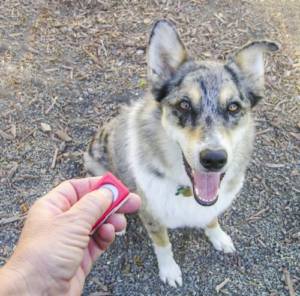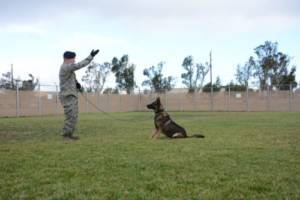Who would not want a trained dog at a vacation where all you need is to take some rest or relax by the beach and your dog not running away. The trick of your dog lying down is not just a trick to make kids happy but is also very important especially if there is a lot of outing involved and you want your dog to patiently settle down at a place and even at your home when you are completing your daily chores and do not want your dog to add on the work.
In this article we are going to find out the simplest ways of getting your dog trained to lie down. The simple ingredients that you will require for this training session is you, your dog and his favourite treat, we are sure that you are handy of all these ingredients already, so let’s go.
Where Should I Start Training My Dog?
Your little pup might have some performance pressure in the beginning and might get afraid of the strange faces in the park, the unfamiliar surroundings or perhaps even other dogs in the park, so try beginning the training at your home itself or anywhere your dog feels comfortable and gradually start taking these training sessions at other locations as well.
The Training Session (Part 1)
Part 1 of your training session comprises of training your dog to sit, we would suggest you to follow either of the simple methods to train your dog to do so, one is called capturing and the other is called luring
Capturing Method-
Step 1- You need to stand in front of your dog with his favourite treat in your hand.
Step 2 – Wait for your dog to sit and the moment he sits say “yes” and appreciate him by giving the treat.
Step 3 – Then step backward or move a little sideways to encourage your dog to stand and wait for him to sit again.
Step 4 – When he sits again appreciate him by your touch and feeding him his favourite treat, let your dog know that his very act of resting in a position is getting approved and making you happy and then
Step 5 – slowly start saying ‘sit’ waiting for him to sit down
Luring Method –
Step 1 – Sit down in front of your dog and hold his favourite treat as a lure.
Step 2 – Take the treat in front of your dog’s nose and let him sniff it and compel to take it from you, but do not give to him yet.
Step 3 – Now gradually lift the food above his head, this will make your dog sit because he will lift his head to raid the treat in your hand. Let him take the treat from your hands when his bottom touches the ground.
Step 4 – Keep repeating it with your dog with the food as the lure. Now keep the treats away and try doing it with your bare hands and if your dog sits reward him by giving a treat.
Step 5 – Your dog at this stage will understand why he is being appreciated and you can begin saying ‘sit’ right before you give the hand signal
Caution – Remain patient even if your dog is failing at multiple attempts and avoid using any physical force to make your dog sit as that might confuse or upset the dog.
Training Session (Part 2)
Once your dog has learned to sit, we just need to follow a 5 step simple sequence to train your dog to lie down.
Step 1 – Get your dog’s favourite treat and hold it in your hands, let your dog come in front of you and after he does, command him to sit.
Step 2 – Not take the treat into your fist and close it, take your closed fist in front of your dog’s nose and let him sniff and smell it but ensure that he does not raid the treat away from your hands.
Step 3 – Now gradually keep lowering down your fist full of treat, down his chest and wait until your dog completely lies down.
Step 4 – Once your dog completely lies down, appreciate your dog by your touch and feeding him the treat in your fist by which you have been luring him.
Step 5 – Keep repeating this sequence two to three times and then start adding the command “down” as he lowers himself down as mentioned in step 3. But before you add the cue “down” you need to ensure that your dog is actually lowering down and you are not doing it in haste as you to have label the correct behaviour.

Don’t get disheartened if your dog gets up within your training session, if he does, all you need to do is to go back to step 1 again and command him to sit.
What If Your Dog Cannot Have A Treat?
I have come across many friends and colleagues and they share that there dog has kidney failure, or weight issues. For them I suggest that they can switch on to healthy treats such as carrots and green legumes, but your dog might not respond well to such healthy alternatives of treats, in that case you can use a clicker. Clicker is a tool for positive reinforcement and you can produce the clicker sound whenever your dog responds in a way you wanted him to respond.

For example, you command your dog to sit, when he sits (clicker), when your dog lies down (clicker).
Why Is My Dog Not Lying Down in Different Places Other Than The Place Where He Was Trained?
Dogs might not be good at generalizations as much as good they are in specifics. It is very pertinent to remember this. It might be because you might be facing a different direction, there might be some different noises coming from around or you might be using some different body language to command your dog to sit.
The list does not end, the only solution to this problem is patience, you need to start training your dog in different environments and conditions and your dog will learn to generalise all the cues for all the different environments and will become confident to perform the trained behaviours in different surroundings and circumstances.
What is the best time for my dog for such training?
You definitely do not want your dong to be fully pumped up and active, so try taking these training sessions for your dog after he is fully exercised and has spent most of his energy playing. Which means avoid training your dog to lie down, especially when he had just woken up or took a power nap, as after that all he will be in a mood of playing and running and not any training sessions
Conclusion –
Patience is the word and a request that we are using for perhaps the third time as we realise that how badly do you want your dog to be trained in behaviours and etiquettes. Do not use any kind of force or coercion as that will not just failing your training but also might end up deteriorating your relation and trust in the eyes of your dog.
Don’t forget to reward and appreciate appropriate behaviours, as there is a lot of learning involved and you need to signal your dog of the behaviours you approve and also the behaviours that you appreciate and you want him to do
Source –
https://www.wikihow.com/Teach-a-Dog-to-Lie-Down
